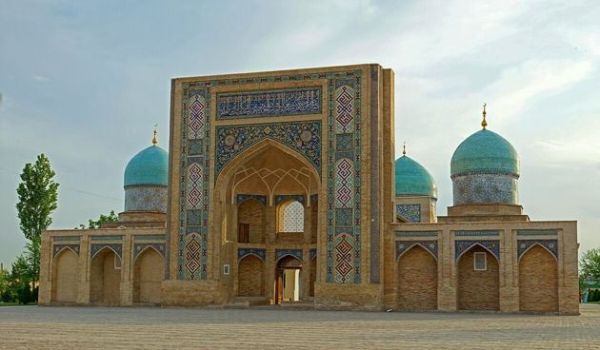Surkhan State Nature Reserve
The Surkhan State Reserve is located in the northwestern part of the Sherabad district of the Surkhandarya region and consists of two independent sections: the Aral-Paigambar island and the eastern slope of the Kugitang-tau ridge. The Aral-Paygambara site with a total area of 3,092 hectares was established as a nature reserve back in 1971 in order to preserve the Tugai valley ecosystem and the natural population of the Bukhara deer, listed on the International IUCN Red List and the Red Book of the former Soviet Union. Currently, by the decision of the Government of the Republic of Uzbekistan, the Aral-Paygambar Island has been transferred to the border guard service.
In 1986. The Kugitang State Reserve was merged with the Aral-Paigambar Nature Reserve and transformed into the Surkhan State Reserve. Currently, the territory of the Surkhan Nature Reserve is located in the southwestern foothills of the Gissar range of the Pamiro-Balai mountain system at an altitude of 1,500 to 3,157 m above sea level. In the southwest of the republic, peripheral parts and foothills of the Gissar range, such as Yakkabag, Chakchar, Baysunsky, Kugitangsky and Surkhantau, fan out. These mountain systems are located in close proximity to the hot Kyzylkum desert. The plains are intersected by the Amu Darya and Syr Darya rivers. The reserve borders on the west with the Republic of Turkmenistan, where there are two sanctuaries and one nature reserve. This makes it possible to organize an interstate cross-border nature reserve in order to preserve the biodiversity of the Kugitanga Mountains. The total area of the reserve is 24583 hectares , of which the forested area was 9284 hectares.
The climate of the reserve is characterized by continentality, aridity, abundance of heat and light, low humidity and strong hot winds ("Afghans").The air temperature in winter is mostly positive and ranges from +2 °C to +3.5 ° C. The absolute maximum air temperature in summer ranges from + 32 °C to 52 ° C. Precipitation falls in the form of rain and snow mainly in the autumn-winter-spring periods. Precipitation ranges from 405 – 410 mm. Snow cover appears in the second half of December and lasts until February. The duration of the frost-free period is 284-289 days.
Currently, 578 species of vascular plants belonging to 269 genera and 55 families have been registered in the Kugitang Nature Reserve, and 23 species of vascular plants listed in the Red Book of the Republic of Uzbekistan have been identified. There are many unique and endemic species among the plants that grow only here on the Kugitang ridge. These include such species as: Willis's astragalus-Astragalus willisii M. Pop.; almost shakhimardan astragalus-Astragalus, Subschimardanus M. Pop.; lead astragalus-astragalus plumbeus Gontsch.; Bukhara spring-leaf-Zygophyllum bucharicum B. Fedtsch.; Allochrusa kachimovidnaya-Allochrusa gypsophiloides (Regel) Schischk.
The fauna of the reserve is a complex natural complex peculiar to the natural conditions of the mountains of Central Asia. The reserve has established the presence of 23 species of mammals on the territory of the reserve. Here, as well as among birds, there are species typical of the southern part of the Palearctic. The striped hyena hyaena hyaena and the Central Asian leopard panthera pardus are still preserved within the reserve, both species are extremely rare and are on the verge of complete extinction in the Republic of Uzbekistan. However, the leopard has been observed several times over the past few years, and the hyena tracks have been noted by the reserve's rangers. Two other species found in the reserve are also on the verge of extinction - the screw-horned goat or marhur (Capra falconeri) and the Bukhara urial (Ovis vignei bocharensis). The number of marhur within the reserve is estimated at 160-180 individuals. The Bukhara urial, whose habitats are arid lowlands and foothills, is even more rare. Its population in the reserve is only 20-25 individuals. not exactly established. In addition to these species, the reserve is home to several other rare species in need of protection and restoration. There is a large white-bellied red-eared bat here, Otonycteris hemprichi, a naturally rare and therefore vulnerable species. It is also home to the Turkestan lynx, a vulnerable, declining species. Gazella subgutturosa jeyran is noted in the foothill plain, the number of which has also decreased catastrophically in recent decades.Of the common species, it is necessary to name a fox, a jackal, a badger, a jackrabbit, an eared hedgehog, a wild boar.
More than 200 species of birds have been recorded in the reserve (74 species of birds in the mountainous territory of the reserve, 143 species belonging to 91 genera, 43 families, and 15 orders on the Aral-Paygambar Island. Among the rare and vulnerable bird species, it is necessary to note the nesting in the reserve of the Turkestan white stork - ciconia ciconia, black stork - ciconia nigra, bearded barn owl - Gypaetus barbatus, bald vulture - Gyps fulvus, black vulture - aegypius monachus, snake-circaetus gallicus, golden eagle - aquila chrysaetos and some others.


